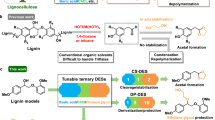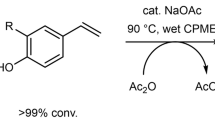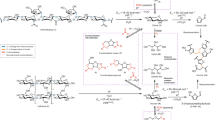Abstract
The use of organic solvents in biomass conversion reactions can lead to high rates and improved selectivities. Here, we elucidate the effects of organic solvent mixtures with water on the kinetics of acid-catalysed dehydration reactions of relevance to biomass conversion. Based on results from reaction kinetics studies, combined with classical and ab initio molecular dynamics simulations, we show that the rates of acid-catalysed reactions in the liquid phase can be enhanced by altering the extents of solvation of the initial and transition states of these catalytic processes. The extent of these effects increases as the number of vicinal hydroxyl or oxygen-containing groups in the reactant increases, moving from an alcohol (butanol), to a diol (1,2-propanediol), to a carbohydrate (fructose). We demonstrate that the understanding of these solvation effects can be employed to optimize the rate and selectivity for production of the biomass platform molecule hydroxymethylfurfural from fructose.
This is a preview of subscription content, access via your institution
Access options
Access Nature and 54 other Nature Portfolio journals
Get Nature+, our best-value online-access subscription
$29.99 / 30 days
cancel any time
Subscribe to this journal
Receive 12 digital issues and online access to articles
$119.00 per year
only $9.92 per issue
Buy this article
- Purchase on Springer Link
- Instant access to full article PDF
Prices may be subject to local taxes which are calculated during checkout




Similar content being viewed by others
References
Chheda, J. N., Huber, G. W. & Dumesic, J. A. Liquid-phase catalytic processing of biomass-derived oxygenated hydrocarbons to fuels and chemicals. Angew. Chem. Int. Ed. 46, 7164–7183 (2007).
Corma, A., Iborra, S. & Velty, A. Chemical routes for the transformation of biomass into chemicals. Chem. Rev. 107, 2411–2502 (2007).
Huber, G. W., Iborra, S. & Corma, A. Synthesis of transportation fuels from biomass: chemistry, catalysts, and engineering. Chem. Rev. 106, 4044–4098 (2006).
Roman-Leshkov, Y., Chheda, J. N. & Dumesic, J. A. Phase modifiers promote efficient production of hydroxymethylfurfural from fructose. Science 312, 1933–1937 (2006).
van Putten, R. J. et al. Hydroxymethylfurfural, a versatile platform chemical made from renewable resources. Chem. Rev. 113, 1499–1597 (2013).
Zakrzewska, M. E., Bogel-Lukasik, E. & Bogel-Lukasik, R. Ionic liquid-mediated formation of 5-hydroxymethylfurfural—a promising biomass-derived building block. Chem. Rev. 111, 397–417 (2011).
Zhao, H. B., Holladay, J. E., Brown, H. & Zhang, Z. C. Metal chlorides in ionic liquid solvents convert sugars to 5-hydroxymethylfurfural. Science 316, 1597–1600 (2007).
Binder, J. B. & Raines, R. T. Simple chemical transformation of lignocellulosic biomass into furans for fuels and chemicals. J. Am. Chem. Soc. 131, 1979–1985 (2009).
Huber, G. W., Chheda, J. N., Barrett, C. J. & Dumesic, J. A. Production of liquid alkanes by aqueous-phase processing of biomass-derived carbohydrates. Science 308, 1446–1450 (2005).
Rosatella, A. A., Simeonov, S. P., Frade, R. F. M. & Afonso, C. A. M. 5-Hydroxymethylfurfural (HMF) as a building block platform: biological properties, synthesis and synthetic applications. Green. Chem. 13, 754–793 (2011).
Swift, T. D. et al. Kinetics of homogeneous Brønsted acid catalyzed fructose dehydration and 5-hydroxymethyl furfural rehydration: a combined experimental and computational study. ACS Catal. 4, 259–267 (2014).
Akien, G. R., Qi, L. & Horvath, I. T. Molecular mapping of the acid catalysed dehydration of fructose. Chem. Commun. 48, 5850–5852 (2012).
Carey, F. A. & Sundberg, R. J. Advanced Organic Chemistry. Part A: Structure and Mechanisms 346–347 (Springer, New York, NY, 2007).
Willi, A. V. in Comprehensive Chemical Kinetics Vol. 8 (eds Bamford, C. H. & Tipper, C. F.) Ch. 1, 21–24 (Elsevier, Amsterdam, 1997).
Cox, B. G. Acids and Bases: Solvent Effects on Acid (Oxford Univ. Press, Oxford, 2013).
Waghorne, W. E. Thermodynamics of solvation in mixed solvents. Chem. Soc. Rev. 22, 285–292 (1993).
Reichardt, C. & Welton, T. Solvents and Solvent Effects in Organic Chemistry 4th edn 165–173 (Wiley-VCH, Weinheim, 2011).
Madon, R. J. & Iglesia, E. Catalytic reaction rates in thermodynamically non-ideal systems. J. Mol. Catal. A Chem. 163, 189–204 (2000).
Chia, M. et al. Selective hydrogenolysis of polyols and cyclic ethers over bifunctional surface sites on rhodium-rhenium catalysts. J. Am. Chem. Soc. 133, 12675–12689 (2011).
Lotze, S., Groot, C. C. M., Vennehaug, C. & Bakker, H. J. Femtosecond mid-infrared study of the dynamics of water molecules in water−acetone and water−dimethyl sulfoxide mixtures. J. Phys. Chem. B 119, 5228–5239 (2015).
Wallace, V. M., Dhumal, N. R., Zehentbauer, F. M., Kim, H. J. & Kiefer, J. Revisiting the aqueous solutions of dimethyl sulfoxide by spectroscopy in the mid- and near-infrared: experiments and Car–Parrinello simulations. J. Phys. Chem. B 119, 14780–14789 (2015).
Mizuno, K., Imafuji, S., Ochi, T., Ohta, T. & Maeda, S. Hydration of the CH groups in dimethyl sulfoxide probed by NMR and IR. J. Phys. Chem. B 104, 11001–11005 (2000).
Kirchner, B. Theory of complicated liquids: investigation of liquids, solvents and solvent effects with modern theoretical methods. Phys. Rep. 440, 1–111 (2007).
Kalidas, C., Hefter, G. & Marcus, Y. Gibbs energies of transfer of cations from water to mixed aqueous organic solvents. Chem. Rev. 100, 819–852 (2000).
Ripin, D. H. & Evans, D. A. Evan’s pKa Table (Harvard University, 2005); http://evans.rc.fas.harvard.edu/pdf/evans_pKa_table.pdf
Fujinaga, T. & Sakamoto, I. Electrochemical studies of sulfonates in non-aqueous solvents. J. Electroanal. Chem. Interfacial Electrochem. 85, 185–201 (1977).
Das, K., Das, A. K. & Kundu, K. K. Ion–solvent interactions in acetonitrile + water mixtures. Electrochim. Acta 26, 471–478 (1981).
Cox, B. G., Natarajan, R. & Waghorne, W. E. Thermodynamic properties for transfer of electrolytes from water to acetonitrile and to acetonitrile + water mixtures. J. Chem. Soc. Faraday Trans. 1 75, 86–95 (1979).
Majindar, K., Lahiri, S. C. & Mukherjee, D. C. Thermodynamics of transfer of hydrogen ion from water to dioxane-water mixtures. J. Indian Chem. Soc. 70, 365–374 (1993).
Mellmer, M. A. et al. Solvent effects in acid-catalyzed biomass conversion reactions. Angew. Chem. Int. Ed. 53, 11872–11875 (2014).
Zhang, J., Das, A., Assary, R. S., Curtiss, L. A. & Weitz, E. A combined experimental and computational study of the mechanism of fructose dehydration to 5-hydroxymethylfurfural in dimethylsulfoxide using Amberlyst 70, PO43-/niobic acid, or sulfuric acid catalysts. Appl. Catal. B 181, 874–887 (2016).
Mushrif, S. H., Caratzoulas, S. D. & Vlachos, G. Understanding solvent effects in the selective conversion of fructose to 5-hydroxymethyl-furfural: a molecular dynamics investigation. Phys. Chem. Chem. Phys. 14, 2637–2644 (2012).
Enslow, K. R. & Bell, A. T. The role of metal halides in enhancing the dehydration of xylose to furfural. ChemCatChem 7, 479–489 (2015).
Marcotullio, G. & De Jong, W. Furfural formation from d-xylose: the use of different halides in dilute aqueous acidic solutions allows for exceptionally high yields. Carbohydr. Res. 346, 1291–1293 (2011).
Marcotullio, G. & De Jong, W. Chloride ions enhance furfural formation from d-xylose in dilute aqueous acidic solutions. Green. Chem. 12, 1739–1746 (2010).
Luterbacher, J. S. et al. Nonenzymatic sugar production from biomass using biomass-derived γ-valerolactone. Science 343, 277–280 (2014).
Truhlar, D. G. Inverse solvent design. Nat. Chem. 5, 902–903 (2013).
Struebing, H. et al. Computer-aided molecular design of solvents for accelerated reaction kinetics. Nat. Chem. 5, 952–957 (2013).
Knifton, J. F., Sanderson, J. R. & Stockton, M. E. Tert-butanol dehydration to isobutylene via reactive distillation. Catal. Lett. 73, 55–57 (2001).
Mori, K., Yamada, Y. & Sato, S. Catalytic dehydration of 1,2-propanediol into propanal. Appl. Catal. A 366, 304–308 (2009).
Courtney, T. D., Nikolakis, V., Mpourmpakis, G., Chen, J. G. & Vlachos, D. G. Liquid-phase dehydration of propylene glycol using solid-acid catalysts. Appl. Catal. A 449, 59–68 (2012).
Clever, H. L. & Pigott, S. P. Enthalpies of mixing of dimethylsulfoxide with water and with several ketones at 298.15 K. J. Chem. Thermodyn. 3, 221–225 (1971).
Goates, J. R. & Sullivan, R. J. Thermodynamic properties of the system water–p-dioxane. J. Phys. Chem. 62, 188–190 (1958).
Glew, D. N. & Watts, H. Aqueous nonelectrolyte solutions. Part XII. enthalpies of mixing of water and deuterium oxide with tetrahydrofuran. Can. J. Chem. 51, 1933–1940 (1973).
Zaitseva, A., Pokki, J.-P., Le, H. Q., Alopaeus, V. & Sixta, H. Vapor–liquid equilibria, excess enthalpy, and density of aqueous γ-valerolactone solutions. J. Chem. Eng. Data 61, 881–890 (2016).
Morcom, K. W. & Smith, R. W. Enthalpies of mixing of water + methyl cyanide. J. Chem. Thermodyn. 1, 503–505 (1969).
Abraham, M. J. et al. GROMACS: high performance molecular simulations through multi-level parallelism from laptops to supercomputers. SoftwareX 1, 19–25 (2015).
Hutter, J., Iannuzzi, M., Schiffmann, F. & VandeVondele, J. Cp2k: atomistic simulations of condensed matter systems. WIREs Comput. Mol. Sci. 4, 15–25 (2014).
Goga, N., Rzepiela, A. J., De Vries, A. H., Marrink, S. J. & Berendsen, H. J. C. Efficient algorithms for langevin and DPD dynamics. J. Chem. Theory Comput. 8, 3637–3649 (2012).
Parrinello, M. & Rahman, A. Polymorphic transitions in single crystals: a new molecular dynamics method. J. Appl. Phys. 52, 7182–7190 (1981).
Nosé, S. & Klein, M. L. Constant pressure molecular dynamics for molecular systems. Mol. Phys. 50, 1055–1076 (1983).
Jorgensen, W. L., Maxwell, D. S. & Tirado-Rives, J. Development and testing of the OPLS all-atom force field on conformational energetics and properties of organic liquids. J. Am. Chem. Soc. 118, 11225–11236 (1996).
Kony, D., Damm, W., Stoll, S. & Van Gunsteren, W. F. An improved OPLS-AA force field for carbohydrates. J. Comput. Chem. 23, 1416–1429 (2002).
Berendsen, H. J. C., Grigera, J. R. & Straatsma, T. P. The missing term in effective pair potentials. J. Phys. Chem. 91, 6269–6271 (1987).
Miyamoto, S. & Kollman, P. A. Settle: an analytical version of the SHAKE and RATTLE algorithm for rigid water models. J. Comput. Chem. 13, 952–962 (1992).
Perdew, J. P., Burke, K. & Ernzerhof, M. Generalized gradient approximation made simple. Phys. Rev. Lett. 77, 3865–3868 (1996).
VandeVondele, J. & Hutter, J. Gaussian basis sets for accurate calculations on molecular systems in gas and condensed phases. J. Chem. Phys. 127, 114105 (2007).
Goedecker, S., Teter, M. & Hutter, J. Separable dual-space Gaussian pseudopotentials. Phys. Rev. B 54, 1703–1710 (1996).
Grimme, S., Ehrlich, S. & Goerigk, L. Effect of the damping function in dispersion corrected density functional theory. J. Comput. Chem. 32, 1456–1465 (2011).
Bussi, G., Donadio, D. & Parrinello, M. Canonical sampling through velocity rescaling. J. Chem. Phys. 126, 14101 (2007).
Grossfield, A. WHAM: the weighted histogram analysis method, version 2.0.9 (Rochester University, Rochester, NY, 2013); http://membrane.urmc.rochester.edu/content/wham
Sunda, A. P. & Venkatnathan, A. Molecular dynamics simulations of triflic acid and triflate ion/water mixtures: a proton conducting electrolytic component in fuel cells. J. Comput. Chem. 32, 3319–3328 (2011).
Acknowledgements
This work was supported in part by the Department of Energy Great Lakes Bioenergy Research Center (https://www.glbrc.org), which is supported by the US Department of Energy, Office of Science, Office of Biological and Environmental Research, through the Cooperative Agreement BER DE-FC02-07ER64494 between The Board of Regents of the University of Wisconsin System and by the National Science Foundation Engineering Research Center for Biorenewable Chemicals (https://www.cbirc.iastate.edu) under Award No. EEC-0813570. Any opinions, findings, and conclusions or recommendations expressed in this material are those of the authors and do not necessarily reflect the views of the National Science Foundation. J.A.D. was supported by the US Department of Energy, Office of Basic Energy Sciences (DE-SC0014058). The authors acknowledge the Minnesota Supercomputing Institute (https://www.msi.umn.edu/) at the University of Minnesota for providing resources that contributed to the research results reported within this article. M.N. thanks M. Mahanthappa for helpful discussions.
Author information
Authors and Affiliations
Contributions
M.A.M., B.D. and K.M. carried out the reaction kinetics experiments and analysed the data. C.S. and P.B. performed the molecular dynamics simulations and density functional theory calculations. M.A.M. and J.A.D. conceived the work, and all authors designed and discussed the experimental and computational research. All authors were involved in writing the manuscript.
Corresponding author
Ethics declarations
Competing interests
The authors declare no competing interests.
Additional information
Publisher’s note: Springer Nature remains neutral with regard to jurisdictional claims in published maps and institutional affiliations.
Supplementary information
Supplementary Information
Supplementary Tables 1–7; Supplementary Discussion; Supplementary Figures 1–24; Supplementary References.
Rights and permissions
About this article
Cite this article
Mellmer, M.A., Sanpitakseree, C., Demir, B. et al. Solvent-enabled control of reactivity for liquid-phase reactions of biomass-derived compounds. Nat Catal 1, 199–207 (2018). https://doi.org/10.1038/s41929-018-0027-3
Received:
Accepted:
Published:
Issue Date:
DOI: https://doi.org/10.1038/s41929-018-0027-3
This article is cited by
-
Photocatalytic conversion of sugars to 5-hydroxymethylfurfural using aluminium(III) and fulvic acid
Nature Communications (2023)
-
Green solvent enabled scalable processing of perovskite solar cells with high efficiency
Nature Sustainability (2023)
-
Environmentally benign synthesis of quinazoline-based heterocyclic compounds over zeolite H-BEA catalyst with bimodal porosity
Journal of Chemical Sciences (2023)
-
Effect of Hybridization of Inorganic/Organic Acid as the Liquefaction Catalyst on the Properties of Liquefied Kenaf Polyols
Journal of Polymers and the Environment (2023)
-
Importance of interface open circuit potential on aqueous hydrogenolytic reduction of benzyl alcohol over Pd/C
Nature Communications (2022)



